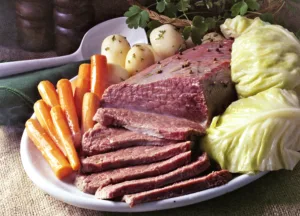The Origins of Corned Beef
Corned beef, with its succulent taste and rich history, has traversed continents and centuries, captivating palates worldwide.
The term “corned beef” is thought to have originated from the English term “corn,” which referred to the coarse grains of salt used in the curing process. This preservation method dates back centuries, to an era when refrigeration was nonexistent, and preserving meat was essential for survival. The practice of curing meat with salt has ancient origins, with evidence of salted meats found in ancient Chinese and Roman cultures.

The story of corned beef as we know it today truly begins in medieval Europe, where salt was a precious commodity and a cornerstone of culinary preservation. In the British Isles, particularly in Ireland, corned beef emerged as a staple food item due to the abundance of salt and widespread cattle farming. During the Middle Ages, beef was salted and preserved in large quantities, providing sustenance during lean times and long voyages at sea.
However, it was not until the 17th century that corned beef rose to prominence on the global stage, thanks to the interplay of trade, colonisation, and cultural exchange. Ireland, renowned for its beef production, became a major exporter of salted beef to the British colonies in North America and the Caribbean. Irish immigrants brought their culinary traditions with them, including the consumption of corned beef, which soon became a dietary mainstay in regions such as New England and the Caribbean islands.
In the New World, corned beef found fertile ground for innovation and adaptation. In colonial America, corned beef became a popular dish among settlers, who embraced it as a hearty and nourishing meal. It was often enjoyed with cabbage, potatoes, and other vegetables, a precursor to the iconic dish known as corned beef and cabbage, which would later become synonymous with Irish-American cuisine, particularly during St. Patrick’s Day celebrations.
Meanwhile, in the Caribbean, corned beef underwent further transformation, influenced by the culinary traditions of African, indigenous, and European cultures. In islands such as Jamaica and Barbados, corned beef became a key ingredient in dishes like “bully beef,” a flavoursome stew made with corned beef, tomatoes, onions, and spices. This fusion of culinary influences reflects the dynamic nature of food culture in the Caribbean, where diverse ingredients and cooking techniques converge to create vibrant and eclectic dishes.
As the centuries progressed, corned beef continued to evolve, adapting to changing tastes and culinary trends. In the 19th and 20th centuries, technological advancements, such as the invention of canning, made corned beef more accessible and convenient, further popularising it as a pantry staple in households around the world.
Today, corned beef remains a beloved dish, cherished for its rich flavour, versatility, and cultural significance. Whether enjoyed in a traditional Irish-American feast or as a spicy Jamaican stew, corned beef continues to captivate taste buds and evoke a sense of nostalgia for bygone eras.
In tracing the origins of corned beef, we uncover not just a culinary history but a tapestry of human experience, shaped by migration, trade, and the enduring quest for sustenance and flavour. From its humble beginnings in medieval Europe to its global embrace in the modern era, corned beef stands as a testament to the enduring power of food to connect us across time and space.